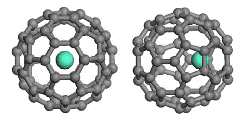Department of Chemistry
Document Type
Article
Date of this Version
4-1-2006
Abstract
High-level ab initio molecular-orbital methods have been employed to determine the relative stability among four neutral and anionic B20 isomers, particularly the double-ring tubular isomer versus three low-lying planar isomers. Calculations with the fourth-order Møller-Plessset perturbation theory [MP4(SDQ)] and Dunning’s correlation consistent polarized valence triple zeta basis set as well as with the coupled-cluster method including single, double, and noniteratively perturbative triple excitations and the 6-311G(d) basis set show that the double-ring tubular isomer is appreciably lower in energy than the three planar isomers and is thus likely the global minimum of neutral B20 cluster. In contrast, calculations with the MP4(SDQ) level of theory and 6-311 +G(d) basis set show that the double-ring anion isomer is appreciably higher in energy than two of the three planar isomers. In addition, the temperature effects on the relative stability of both 10B20- and 11B20- anion isomers are examined using the density-functional theory. It is found that the three planar anion isomers become increasingly more stable than the double-ring isomer with increasing the temperature. These results are consistent with the previous conclusion based on a joint experimental/simulated anion photoelectron spectroscopy study [B. Kiran et al., Proc. Natl. Acad. Sci. U.S.A. 102, 961 (2005)], that is, the double-ring anion isomer is notably absent from the experimental spectra. The high stability of the double-ring neutral isomer of B20 can be attributed in part to the strong aromaticity as charaterized by its large negative nucleus-independent chemical shift. The high-level ab initio calculations suggest that the planar-to-tubular structural transition starts at B20 for neutral clusters but should occur beyond the size of B20- for the anion clusters.



Comments
Published by American Institute of Physics. J. Chem. Physics 124, 154310 2006. ©2006 American Institute of Physics. Permission to use. http://jcp.aip.org/.